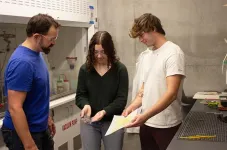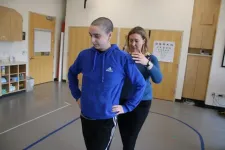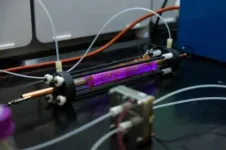(Press-News.org) Patience — like its corollary impatience — has always been a sort of “I know it when I see it” concept. And that didn’t sit well with UC Riverside psychology researcher Kate Sweeny.
“Philosophers and religious scholars call patience a virtue, yet most people claim to be impatient,” Sweeny said. “That made me wonder if maybe patience is less about being a good person and more about how we deal with day-to-day frustrations.”
For purposes of her research, Sweeny sought to better define what constitutes patience, and impatience, and the factors that determine them.
Impatience, she concluded across three studies of 1,200 people, is the emotion people feel when they face a delay that seems unfair, unreasonable, or inappropriate—like a traffic jam outside of rush hour, or a meeting that should have ended 15 minutes ago. Patience, then, is how we cope with those feelings of impatience.
The studies’ findings were published recently in the journal Personality and Social Psychology Bulletin in the article “When Time is the Enemy: An Initial Test of the Process Model of Patience.”
Psychologists use the term “emotion regulation” to capture the many strategies people use to reduce (or sometimes increase) the intensity of their emotions. Patience, Sweeny asserts in a companion theoretical paper, is the subset of these strategies that particularly target feelings of impatience.
The first studies to test that idea were recently published in the article “When Time is the Enemy: An Initial Test of the Process Model of Patience,” in the journal Personality and Social Psychology Bulletin.
The studies asked participants to consider their responses to various frustrating situations one might encounter in everyday life. One depicted a traffic jam, another described a long, boring meeting, and others prompted them to imagine being stuck in a waiting room.
Participants indicated how impatient they would feel in response to each, then whether they would counter their impatience through strategies like distraction, deep breathing, or seeing the upsides of the situation.
The study results identified three scenarios that create a “perfect storm” for impatience: when the stakes are relatively high (traffic on the way to a favorite band’s concert), when the state of waiting is unpleasant (no seats and no distractions at the DMV), and when someone is clearly to blame for the delay (the lab forgot to process your medical test). People also felt more impatient when a delay was longer than they anticipated—but surprisingly, not when they delay was relatively long or short.
Although nearly everyone in the studies said they would feel at least a bit impatient when facing those frustrating situations, some people were more patient than others. Participants who were more comfortable with open-ended situations and more emotionally stable (i.e., low in need for closure and neuroticism) said they wouldn’t feel too impatient in those scenarios; those who were more emotionally skilled and better at self-regulation said they would respond more patiently, even if they initially felt impatient. Being agreeable and high in empathy also predicted patience.
“Our initial findings support many of our ideas about patience and impatience,” Sweeny concludes. “We have a lot still to learn, but our approach is quite promising in terms of helping people to manage feelings of impatience and ultimately become more patient in their daily lives.”
Co-authors for “When Time is the Enemy” included graduate researchers Jason Hawes and Olivia T. Karaman. The companion theoretical paper, “On (Im)Patience: A New Approach to an Old Virtue,” was published in the journal Personality and Social Psychology Review.
END
Patience isn't a virtue; it's a coping mechanism
Studies sought to better define what constitutes patience, and impatience, and the factors that determine them
2024-12-20
ELSE PRESS RELEASES FROM THIS DATE:
The Lancet Psychiatry: Autism spectrum disorder ranks among the top 10 causes of non-fatal health burden in youth
2024-12-20
A new global analysis reveals that an estimated 61.8 million people in 2021 were autistic —equivalent to 1 in every 127 individuals. Conducted as part of the Global Burden of Diseases, Injuries, and Risk Factors Study (GBD) 2021, the research identifies autism spectrum disorder (ASD) as one of the top ten causes of non-fatal health burden for youth under 20 years old.
Key findings reveal stark disparities: the global prevalence of ASD is significantly higher among males, at 1,065 cases per 100,000 males, almost double of global prevalence among females (508 per 100,000 females). Regions like High-Income ...
Innovative glue maker chosen for Japanese startup program
2024-12-20
The eco-friendly glue company D-Glue, co-created by a Cal Poly chemistry research team with student involvement in partnership with an East Coast company, has joined an international corporate incubator program as of Dec. 1.
Plug and Play, a global innovation platform that links startups, corporations, investors, universities and government agencies, has over 60 locations across the world, reaching across 25 industries. Plug and Play’s three-month international program matches startups with business investors among its 45 Japanese corporate ...
Digital labels can help grocers waste less food
2024-12-20
In 2022, U.S. grocers wasted 5 million tons of food, with 35% of it going to landfills, according to the food waste nonprofit ReFed. More than half of that waste — 2.7 million tons — was past the labels’ expiration dates.
But there’s a potential technological solution to the waste problem, according to new research from Texas McCombs. By moving from paper shelf labels to digital ones, supermarkets can easily lower prices and move older stock from their shelves to consumers’ homes.
Using technology to quickly change prices on labels, a process known as dynamic pricing, benefits more than just consumers, says Ioannis ...
Clever trick to cook stars like Christmas puds detected for first time
2024-12-20
Clever trick to cook stars like Christmas puds detected for first time
Royal Astronomical Society press release
RAS PR 24/33
Embargoed until 00:01 GMT on Friday 20 December 2024
The missing ingredient for cooking up stars in the same way you might steam your Christmas pudding has been spotted for the first time by astronomers.
Much like a pressure cooker has a weight on top of its lid to keep the pressure in and get your festive dessert dense, moist and ready to eat, merging galaxies may need magnetic fields to create the ideal conditions for star formation.
Until now, however, the existence of such a force had only been ...
By looking at individual atoms in tooth enamel, UW and PNNL researchers are learning what happens to our teeth as we age
2024-12-19
Teeth are essential for helping people break down the food they eat, and are protected by enamel, which helps them withstand the large amount of stress they experience as people chew away. Unlike other materials in the body, enamel has no way to repair damage, which means that as we age, it risks becoming weaker with time.
Researchers are interested in understanding how enamel changes with age so that they can start to develop methods that can keep teeth happier and healthier for longer.
A research team at the University of Washington and the ...
Volunteers should not become friends with patients
2024-12-19
When a volunteer supports a patient, a special and often rather unequal relationship can develop between the helper and the person receiving the help. Researchers have now investigated this relationship and offer guidance on finding the right balance.
When people get sick, they often depend on family or friends to help them out. In Norway, there are also public services that usually support people who need it.
“But public services or family and friends are not always enough. Volunteers and non-profit organizations are increasingly being used to provide care to the population,” says Associate Professor Gunhild Tøndel at ...
Men and residents of higher crime areas see greater benefit from community parks, in reduction of deaths from heart disease
2024-12-19
There’s a well-established link between greenspace and health benefits, including lower rates of heart disease risk factors, such as high blood pressure and diabetes. Now, according to a recently published study, rates of deaths from heart disease — especially among men — are lower in neighborhoods with more greenspace. The findings, from researchers at Drexel University’s Dornsife School of Public Health, were recently published in the journal Health and Place.
Studying heart disease deaths in Philadelphia from 2008 to 2015, the researchers also found that, ...
Getting rehab earlier improves concussion outcomes, OHSU study suggests
2024-12-19
People who suffer from continued symptoms of concussion should seek a referral to physical therapy as soon as possible, new research from Oregon Health & Science University suggests.
Even though most people naturally recover from concussions within four weeks, the study revealed people who delayed physical therapy had lingering deficits related to their reaction times for balance, motor function — or body movements to perform tasks — and the use of sensory information — as in sight and touch — for balance. The research published this week in the Physical Therapy & Rehabilitation Journal.
“It means they’re ...
Potential culprit identified in lingering Crohn’s disease symptoms
2024-12-19
A study from University of Michigan researchers may provide an explanation for why some patients with Crohn’s disease continue to experience symptoms, even in the absence of inflammation.
The resulting paper, “Why Symptoms Linger in Quiescent Crohn’s Disease: Investigating the Impact of Sulfidogenic Microbes and Sulfur Metabolic Pathways,” appeared in Inflammatory Bowel Disease.
Even in cases of quiescent inflammatory bowel disease—i.e. without the presence of inflammation—nearly one-third of all patients report persistent symptoms.
The problem is especially common ...
Taking a cue from lightning, eco-friendly reactor converts air and water into ammonia
2024-12-19
BUFFALO, N.Y. — There’s a good chance you owe your existence to the Haber-Bosch process.
This industrial chemical reaction between hydrogen and nitrogen produces ammonia, the key ingredient to synthetic fertilizers that supply much of the world’s food supply and enabled the population explosion of the last century.
It may also threaten the existence of future generations. The process consumes about 2% of the world’s total energy supply, and the hydrogen required for the reaction ...
LAST 30 PRESS RELEASES:
University of Oklahoma researcher awarded funding to pursue AI-powered material design
Exploring how the visual system recovers following injury
Support for parents with infants at pediatric check-ups leads to better reading and math skills in elementary school
Kids’ behavioral health is a growing share of family health costs
Day & night: Cancer disrupts the brain’s natural rhythm
COVID-19 vaccination significantly reduces risk to pregnant women and baby
The role of vaccination in maternal and perinatal outcomes associated with COVID-19 in pregnancy
Mayo Clinic smartwatch system helps parents shorten and defuse children's severe tantrums early
Behavioral health spending spikes to 40% of all children’s health expenditures, nearly doubling in a decade
Digital cognitive behavioral treatment for generalized anxiety disorder
Expenditures for pediatric behavioral health care over time and estimated family financial burden
Air conditioning in nursing homes and mortality during extreme heat
The Alps to lose a record number of glaciers in the next decade
What makes a good proton conductor?
New science reporting guide published for journalists in Bulgaria
New international study reveals major survival gaps among children with cancer
New science reporting guide published for journalists in Turkey
Scientists develop a smarter mRNA therapy that knows which cells to target
Neuroanatomy-informed brain–machine hybrid intelligence for robust acoustic target detection
Eight SwRI hydrogen projects funded by ENERGYWERX
The Lundquist Institute and its start-up company Vitalex Biosciences Announces Strategic Advancement of Second-Generation fungal Vaccine VXV-01 through Phase 1 Trials under $40 Million Competitive Con
Fine particles in pollution are associated with early signs of autoimmune disease
Review article | Towards a Global Ground-Based Earth Observatory (GGBEO): Leveraging existing systems and networks
Penn and UMich create world’s smallest programmable, autonomous robots
Cleveland researchers launch first major study to address ‘hidden performance killer’ in athletes
To connect across politics, try saying what you oppose
Modulating key interaction prevents virus from entering cells
Project explores barriers to NHS career progression facing international medical graduates
Jeonbuk National University researchers explore the impact of different seasonings on the flavor perception of Doenjang soup
Two Keck Medicine of USC Hospitals named Leapfrog Top Teaching Hospitals
[Press-News.org] Patience isn't a virtue; it's a coping mechanismStudies sought to better define what constitutes patience, and impatience, and the factors that determine them




